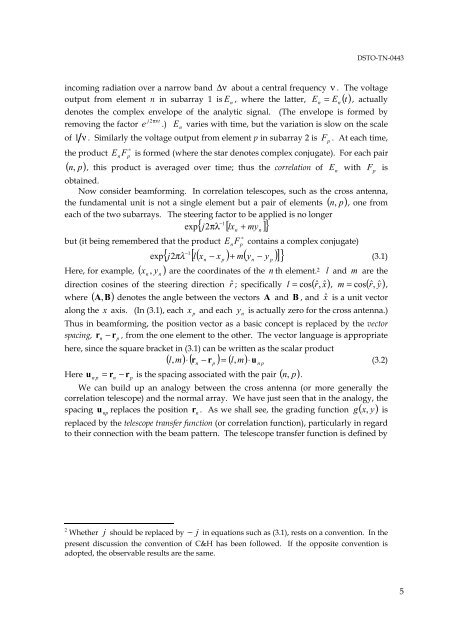Suitability of Correlation Arrays and Superresolution for Minehunting ...
Suitability of Correlation Arrays and Superresolution for Minehunting ...
Suitability of Correlation Arrays and Superresolution for Minehunting ...
Create successful ePaper yourself
Turn your PDF publications into a flip-book with our unique Google optimized e-Paper software.
DSTO-TN-0443<br />
incoming radiation over a narrow b<strong>and</strong> ∆ ν about a central frequency ν . The voltage<br />
output from element n in subarray 1 is E<br />
n<br />
, where the latter, E = n<br />
En<br />
() t , actually<br />
denotes the complex envelope <strong>of</strong> the analytic signal. (The envelope is <strong>for</strong>med by<br />
j t<br />
removing the factor e<br />
2 πν .) E<br />
n<br />
varies with time, but the variation is slow on the scale<br />
<strong>of</strong> 1 ν . Similarly the voltage output from element p in subarray 2 is F<br />
p<br />
. At each time,<br />
∗<br />
the product E is <strong>for</strong>med (where the star denotes complex conjugate). For each pair<br />
n F p<br />
( n, p)<br />
, this product is averaged over time; thus the correlation <strong>of</strong> E n<br />
with<br />
F p<br />
is<br />
obtained.<br />
Now consider beam<strong>for</strong>ming. In correlation telescopes, such as the cross antenna,<br />
the fundamental unit is not a single element but a pair <strong>of</strong> elements ( n, p)<br />
, one from<br />
each <strong>of</strong> the two subarrays. The steering factor to be applied is no longer<br />
exp { j 2πλ −1 [ lx n<br />
+ my n<br />
]}<br />
∗<br />
but (it being remembered that the product E contains a complex conjugate)<br />
n F p<br />
−1<br />
{ j2<br />
[ l( x − x ) + m( y − y )]}<br />
exp πλ (3.1)<br />
n<br />
p<br />
Here, <strong>for</strong> example, ( x<br />
n<br />
, y n<br />
) are the coordinates <strong>of</strong> the n th element. 2 l <strong>and</strong> m are the<br />
direction cosines <strong>of</strong> the steering direction rˆ ; specifically l = cos( rˆ,<br />
xˆ<br />
), m = cos( rˆ,<br />
yˆ<br />
),<br />
where ( A, B)<br />
denotes the angle between the vectors A <strong>and</strong> B , <strong>and</strong> xˆ is a unit vector<br />
along the x axis. (In (3.1), each x<br />
p<br />
<strong>and</strong> each y<br />
n<br />
is actually zero <strong>for</strong> the cross antenna.)<br />
Thus in beam<strong>for</strong>ming, the position vector as a basic concept is replaced by the vector<br />
spacing, rn<br />
− rp<br />
, from the one element to the other. The vector language is appropriate<br />
here, since the square bracket in (3.1) can be written as the scalar product<br />
( l, m) ⋅ ( rn<br />
− rp<br />
) = ( l,<br />
m) ⋅ u<br />
n p<br />
(3.2)<br />
Here u<br />
n p<br />
= rn<br />
− rp<br />
is the spacing associated with the pair ( n, p)<br />
.<br />
We can build up an analogy between the cross antenna (or more generally the<br />
correlation telescope) <strong>and</strong> the normal array. We have just seen that in the analogy, the<br />
spacing u<br />
np<br />
replaces the position r n<br />
. As we shall see, the grading function g ( x, y)<br />
is<br />
replaced by the telescope transfer function (or correlation function), particularly in regard<br />
to their connection with the beam pattern. The telescope transfer function is defined by<br />
n<br />
p<br />
2 Whether j should be replaced by j − in equations such as (3.1), rests on a convention. In the<br />
present discussion the convention <strong>of</strong> C&H has been followed. If the opposite convention is<br />
adopted, the observable results are the same.<br />
5

















